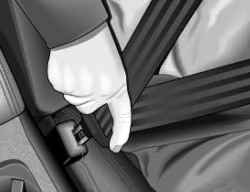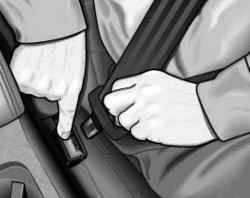 printable version printable version
Seatbelt warning light
The warning lamp reminds the driver and passengers to wear a seat belt. Before driving: - You properly wear a seat belt; - Show my fellow travelers how to put on a seat belt; - Place the child in a children's armchair with back support, which corresponds to the height and age of the child. Dashboard warning lamp lights up when the ignition for a few seconds as a reminder of the need to wear seat belts. In addition, an alarm sounds and the display indication ?«GURT ANLEGEN?» (?«BELTS DON"). The warning light goes out, the indication on the display disappears and the audio signal fades, when the driver wearing a seat belt. If with the ignition the driver is not wearing the seat belt warning lamp in the instrument panel lights up continuously. In addition, there is a 90 with a message ?«GURT ANLEGEN?» (?«BELTS DON") and 10 to turn on a warning tone.
Head-on collisions At frontal collisions extinguished a huge kinetic energy. Explanation of the physical processes occurring in the frontal impact of a vehicle, is quite simple. When the vehicle is in motion, and he found in it the people have the energy of motion, or "kinetic energy." The value of the "kinetic energy" is largely determined by the speed of the vehicle at the time of the collision and the weight of the car and its occupants. With the increasing speed and weight must be "settled" more energy in a collision. The main thing here - it's the speed of the car. For example, if the vehicle speed is doubled from 25 to 50 km / h, the energy of movement increases fourfold. If the vehicle is moving at a speed of 30 to 50 km / h, the collision of the body of the occupant can operate the forces that exceed the value of one ton. At higher speeds will act even more significant in magnitude forces. The driver and passengers who are not wearing seat belts, not "connected" with the car. When a frontal collision, they will move forward with the same speed with which the car was moving before the collision. These same forces are at work not only in a frontal collision but also in other types of accidents. Even when a collision at low speed on the human body are such forces, which are difficult to overcome only by hand. In a frontal collision of the tour participants, who are not wearing seat belts, throws their seats forward, and at the same time they hit the steering wheel, the front panel, windshield, etc. Airbags do not replace seat belts. Airbags at disclosing only give extra protection. The driver and passengers must always wear seat belts properly, and do not remove them until the end of the trip. This significantly reduces the probability of severe injuries during accidents regardless of whether the vehicle is equipped with airbags or not. Keep in mind that air bags are revealed only once. Therefore, you should always wear seat belts to be protected even when the system fails airbags. And for the rear passengers important to wear seat belts in an accident not to be thrown out ahead. Fastened a passenger not only endangering themselves but also poses a threat to the driver or front passenger.
Putting on the seat belt For effective protection of safety belts need to be put right. Adjust the seat and head restraint Taking a tongue strap for uniformly drag ribbon belt chest and pelvis.
Insert the lock tongue into the slot designed for the seat until you hear the click lock (Fig. 1.96). Try to pull the belt up, make sure that the belt is securely fixed. Each machine is equipped with pretensioner rewinding. To control the functional readiness is pretensioner warning light. Each belt is equipped with automatic rewind brachial branches. In slow motion brachial branch provides full freedom of movement. When sudden braking in corners and when accelerating take-up machine is locked shoulder strap. Each seat belt, except the driver's seat belt is equipped with child lock. Be sure to read the rules of use of child lock.
ATTENTION Improper positioning of the belt can cause serious injury in an accident. Most seatbelt protective effect is achieved when the back rest is in a position close to vertical, and put on the passenger seat belt correctly. Never insert the belt tongue into the lock of another seat. When the wrong position the belt can not provide effective protection. If the branches are wrong belt, increasing the likelihood of serious damage. |
Removal of seat belts
| Fig. 1.97. Release of the tongue from the castle
|
Press the red button on the buckle (Fig. 1.97). The tab will jump out. Taps hand strap so that the belt tape unwinds easily and does not damage the upholstery.
ATTENTION Never loosen the belt is worn, even when the car is in motion. Otherwise, it increases the risk of serious and even life-threatening injuries. |
Manual adjustment of the height of the seat belt With manual height adjustment of the seat belt can be adjusted to the length of the shoulder just below the branches of individual physique. Manual adjustment of the seat to the front seats can be used for the correct positioning of the upper branch of belt.
| Fig. 1.98. The bracket for attaching the belt height adjustment on the driver's seat
|
Slide the bracket up or down so that the belt lies against the body
Pretensioners and their effects In a frontal collision the seat belts are automatically tightened. Seat belts front and rear seats are equipped with pretensioners. Pretensioners in the frontal impact only when actuated by the sensors when equipped with the appropriate belt. Pretensioner tightens the belt and thereby limits the forward movement of the occupant. Pretensioner may fire only once. In light of frontal collisions, side impacts and blows to the back of the car, roll-over, as well as in other types of accidents, however when there is no any significant directed while moving force retractors in place are not given.
NOTE When triggered pretensioner appears a little smoke. This is normal and does not indicate the occurrence of the fire on the car. |
Handling Precautions with pretensioners The pretensioners are an integral part of safety belts installed in the vehicle seat. When the execution of the self-tensioners and other parts of the seat-belt straps can be damaged. This may lead to the fact that in case of an accident retractors do not work or will work inefficiently. To ensure the efficiency of the pretensioners and avoid damage seat belts need to follow some precautions, which are known to the specialized workshops.
ATTENTION Pretensioners and seat belts, including unwound machines are not repairable. Any work on the pretensioner and seat belts as a whole, as well as the removal and installation of the individual parts must be carried out only in specialized workshops. Protective functions pretensioner enough for one time only. If the pretensioner is triggered, it must be replaced. |
| 






